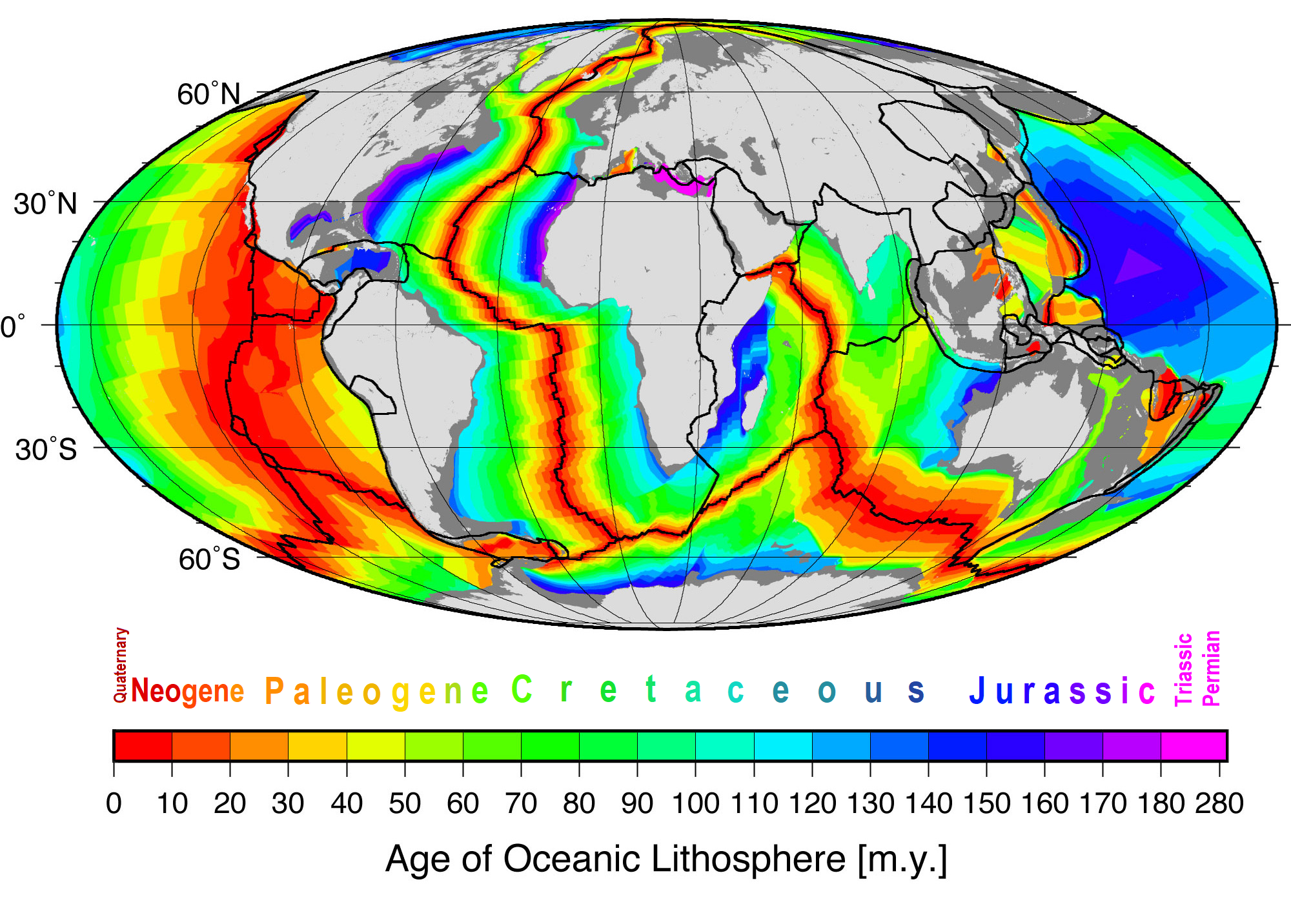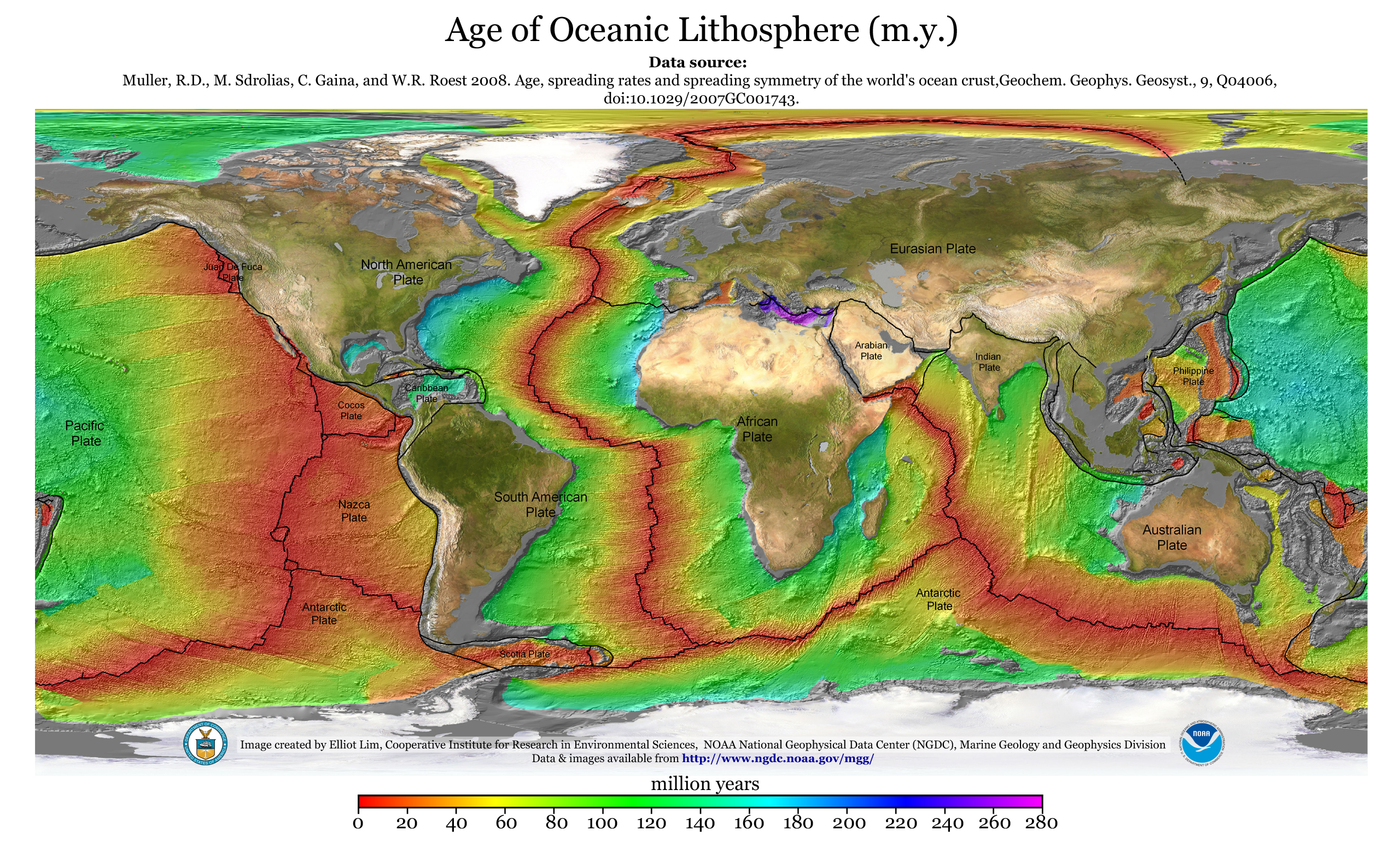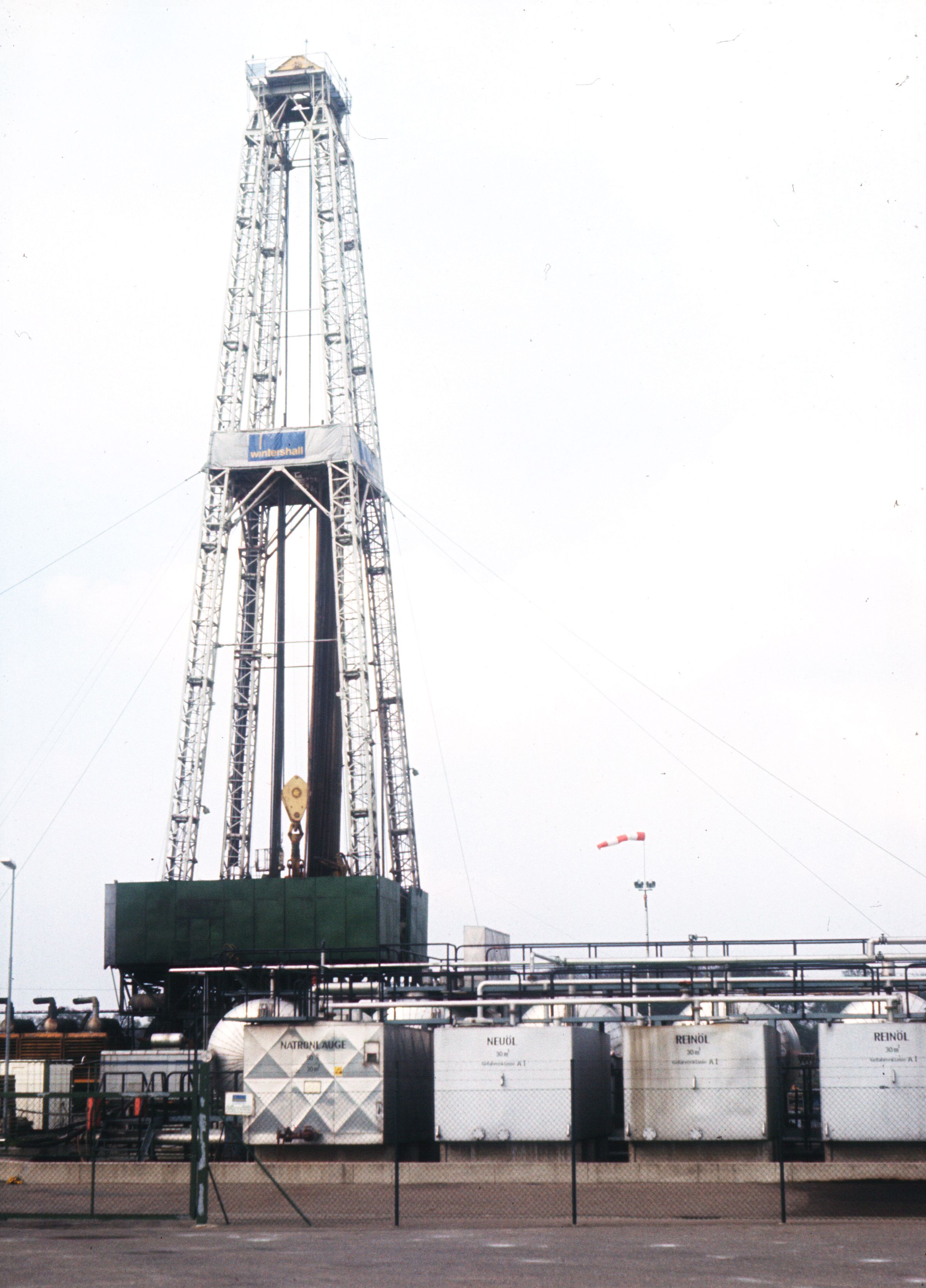|
Marine Geophysics
Marine geophysics is the scientific discipline that employs methods of geophysics to study the world's ocean basins and continental margins, particularly the solid earth beneath the ocean. It shares objectives with marine geology, which uses sedimentological, paleontological, and geochemical methods. Marine geophysical data analyses led to the theories of seafloor spreading and plate tectonics. Methods Marine geophysics uses techniques largely employed on the continents, from fields including exploration geophysics and seismology, and methods unique to the ocean such as sonar. Most geophysical instruments are used from surface ships but some are towed near the seafloor or function autonomously, as with Autonomous Underwater Vehicles or AUVs. Objectives of marine geophysics include determination of the depth and features of the seafloor, the seismic structure and earthquakes in the ocean basins, the mapping of gravity and magnetic anomalies over the basins and margins, ... [...More Info...] [...Related Items...] OR: [Wikipedia] [Google] [Baidu] |
Geophysics
Geophysics () is a subject of natural science concerned with the physical processes and physical properties of the Earth and its surrounding space environment, and the use of quantitative methods for their analysis. The term ''geophysics'' sometimes refers only to solid earth applications: Earth's shape; its gravitational and magnetic fields; its internal structure and composition; its dynamics and their surface expression in plate tectonics, the generation of magmas, volcanism and rock formation. However, modern geophysics organizations and pure scientists use a broader definition that includes the water cycle including snow and ice; fluid dynamics of the oceans and the atmosphere; electricity and magnetism in the ionosphere and magnetosphere and solar-terrestrial physics; and analogous problems associated with the Moon and other planets. Gutenberg, B., 1929, Lehrbuch der Geophysik. Leipzig. Berlin (Gebruder Borntraeger). Runcorn, S.K, (editor-in-chief), 1967, International ... [...More Info...] [...Related Items...] OR: [Wikipedia] [Google] [Baidu] |
Oceanic Crust
Oceanic crust is the uppermost layer of the oceanic portion of the tectonic plates. It is composed of the upper oceanic crust, with pillow lavas and a dike complex, and the lower oceanic crust, composed of troctolite, gabbro and ultramafic cumulates. The crust overlies the rigid uppermost layer of the mantle. The crust and the rigid upper mantle layer together constitute oceanic lithosphere. Oceanic crust is primarily composed of mafic rocks, or sima, which is rich in iron and magnesium. It is thinner than continental crust, or sial, generally less than 10 kilometers thick; however, it is denser, having a mean density of about 3.0 grams per cubic centimeter as opposed to continental crust which has a density of about 2.7 grams per cubic centimeter. The crust uppermost is the result of the cooling of magma derived from mantle material below the plate. The magma is injected into the spreading center, which consists mainly of a partly solidified crystal mush derived from earlier ... [...More Info...] [...Related Items...] OR: [Wikipedia] [Google] [Baidu] |
Side-scan Sonar
Side-scan sonar (also sometimes called side scan sonar, sidescan sonar, side imaging sonar, side-imaging sonar and bottom classification sonar) is a category of sonar system that is used to efficiently create an image of large areas of the sea floor. Uses Side-scan sonar may be used to conduct surveys for marine archaeology; in conjunction with seafloor samples it is able to provide an understanding of the differences in material and texture type of the seabed. Side-scan sonar imagery is also a commonly used tool to detect debris items and other obstructions on the seafloor that may be hazardous to shipping or to seafloor installations by the oil and gas industry. In addition, the status of pipelines and cables on the seafloor can be investigated using side-scan sonar. Side-scan data are frequently acquired along with bathymetric soundings and sub-bottom profiler data, thus providing a glimpse of the shallow structure of the seabed. Side-scan sonar is also used for fisheries ... [...More Info...] [...Related Items...] OR: [Wikipedia] [Google] [Baidu] |
Hertz
The hertz (symbol: Hz) is the unit of frequency in the International System of Units (SI), equivalent to one event (or cycle) per second. The hertz is an SI derived unit whose expression in terms of SI base units is s−1, meaning that one hertz is the reciprocal of one second. It is named after Heinrich Rudolf Hertz (1857–1894), the first person to provide conclusive proof of the existence of electromagnetic waves. Hertz are commonly expressed in multiples: kilohertz (kHz), megahertz (MHz), gigahertz (GHz), terahertz (THz). Some of the unit's most common uses are in the description of periodic waveforms and musical tones, particularly those used in radio- and audio-related applications. It is also used to describe the clock speeds at which computers and other electronics are driven. The units are sometimes also used as a representation of the energy of a photon, via the Planck relation ''E'' = ''hν'', where ''E'' is the photon's energy, ''ν'' is its freq ... [...More Info...] [...Related Items...] OR: [Wikipedia] [Google] [Baidu] |
Hydrophone
A hydrophone ( grc, ὕδωρ + φωνή, , water + sound) is a microphone designed to be used underwater for recording or listening to underwater sound. Most hydrophones are based on a piezoelectric transducer that generates an electric potential when subjected to a pressure change, such as a sound wave. Some piezoelectric transducers can also serve as a sound projector, but not all have this capability, and some may be destroyed if used in such a manner. A hydrophone can detect airborne sounds, but will be insensitive because it is designed to match the acoustic impedance of water, a denser fluid than air. Sound travels 4.3 times faster in water than in air, and a sound wave in water exerts a pressure 60 times that exerted by a wave of the same amplitude in air. Similarly, a standard microphone can be buried in the ground, or immersed in water if it is put in a waterproof container, but will give poor performance due to the similarly bad acoustic impedance match. History The ... [...More Info...] [...Related Items...] OR: [Wikipedia] [Google] [Baidu] |
Hydrocarbon Exploration
Hydrocarbon exploration (or oil and gas exploration) is the search by petroleum geologists and geophysicists for deposits of hydrocarbons, particularly petroleum and natural gas, in the Earth using petroleum geology. Exploration methods Visible surface features such as oil seeps, natural gas seeps, pockmarks (underwater craters caused by escaping gas) provide basic evidence of hydrocarbon generation (be it shallow or deep in the Earth). However, most exploration depends on highly sophisticated technology to detect and determine the extent of these deposits using exploration geophysics. Areas thought to contain hydrocarbons are initially subjected to a gravity survey, magnetic survey, passive seismic or regional seismic reflection surveys to detect large-scale features of the sub-surface geology. Features of interest (known as ''leads'') are subjected to more detailed seismic surveys which work on the principle of the time it takes for reflected sound waves to travel throu ... [...More Info...] [...Related Items...] OR: [Wikipedia] [Google] [Baidu] |
Reflection Seismology
Reflection seismology (or seismic reflection) is a method of exploration geophysics that uses the principles of seismology to estimate the properties of the Earth's subsurface from reflected seismic waves. The method requires a controlled seismic source of energy, such as dynamite or Tovex blast, a specialized air gun or a seismic vibrator. Reflection seismology is similar to sonar and echolocation. This article is about surface seismic surveys; for vertical seismic profiles, see VSP. History Reflections and refractions of seismic waves at geologic interfaces within the Earth were first observed on recordings of earthquake-generated seismic waves. The basic model of the Earth's deep interior is based on observations of earthquake-generated seismic waves transmitted through the Earth's interior (e.g., Mohorovičić, 1910). The use of human-generated seismic waves to map in detail the geology of the upper few kilometers of the Earth's crust followed shortly thereafter and h ... [...More Info...] [...Related Items...] OR: [Wikipedia] [Google] [Baidu] |
Fis01334 (27555144884)
FIS or fis may refer to: Science and technology * ''Fis'', an ''E. Coli'' gene * Fis phenomenon, a phenomenon in linguistics * F♯ (musical note) * Flight information service, an air traffic control service * Frame Information Structure, a Serial ATA technology Organizations * FIS (company), an American financial services company * Fairy Investigation Society * Federal Intelligence Service, a Swiss intelligence service * Festival Internacional de Santander, a Spanish music festival * Fiji Intelligence Services * Fish Information and Services, an international news agency * Flandreau Indian School * Frankfurt International School * French International School of Hong Kong * Fukuoka International School * International Ski Federation (French: ') * Islamic Salvation Front (French: '), a defunct political party in Algeria * Italian Fencing Federation (Italian: ') * Italian Scout Federation (Italian: ') Surname * Julio Fis (born 1974), Spanish handball player * Ljubomir Pavić ... [...More Info...] [...Related Items...] OR: [Wikipedia] [Google] [Baidu] |
Multibeam Echosounder
A multibeam echosounder (MBES) is a type of sonar that is used to map the seabed. It emits acoustic waves in a fan shape beneath its transceiver. The time it takes for the sound waves to reflect off the seabed and return to the receiver is used to calculate the water depth. Unlike other sonars and echo sounders, MBES uses beamforming to extract directional information from the returning soundwaves, producing a swath of depth soundings from a single ping. History and progression Multibeam sonar sounding systems, also known as ''swathe'' (British English) or ''swath'' (American English), originated for military applications. The Sonar Array Sounding System (SASS) was developed in the early 1960s by the US Navy, in conjunction with General Instrument to map large swaths of the ocean floor to assist the underwater navigation of its submarine force. SASS was tested aboard the USS ''Compass Island'' (AG-153). The final array system, composed of sixty-one one degree beams with a swa ... [...More Info...] [...Related Items...] OR: [Wikipedia] [Google] [Baidu] |
World War II
World War II or the Second World War, often abbreviated as WWII or WW2, was a world war that lasted from 1939 to 1945. It involved the vast majority of the world's countries—including all of the great powers—forming two opposing military alliances: the Allies and the Axis powers. World War II was a total war that directly involved more than 100 million personnel from more than 30 countries. The major participants in the war threw their entire economic, industrial, and scientific capabilities behind the war effort, blurring the distinction between civilian and military resources. Aircraft played a major role in the conflict, enabling the strategic bombing of population centres and deploying the only two nuclear weapons ever used in war. World War II was by far the deadliest conflict in human history; it resulted in 70 to 85 million fatalities, mostly among civilians. Tens of millions died due to genocides (including the Holocaust), starvation, ma ... [...More Info...] [...Related Items...] OR: [Wikipedia] [Google] [Baidu] |
Echo Sounding
Echo sounding or depth sounding is the use of sonar for ranging, normally to determine the depth of water (bathymetry). It involves transmitting acoustic waves into water and recording the time interval between emission and return of a pulse; the resulting time of flight, along with knowledge of the speed of sound in water, allows determining the distance between sonar and target. This information is then typically used for navigation purposes or in order to obtain depths for charting purposes. Echo sounding can also be used for ranging to other targets, such as fish schools. Hydroacoustic assessments have traditionally employed mobile surveys from boats to evaluate fish biomass and spatial distributions. Conversely, fixed-location techniques use stationary transducers to monitor passing fish. The word '' sounding'' is used for all types of depth measurements, including those that don't use sound, and is unrelated in origin to the word ''sound'' in the sense of noise or ton ... [...More Info...] [...Related Items...] OR: [Wikipedia] [Google] [Baidu] |
Underwater Acoustic Positioning System
An underwater acoustic positioning system is a system for the tracking and navigation of underwater vehicles or divers by means of acoustic distance and/or direction measurements, and subsequent position triangulation. Underwater acoustic positioning systems are commonly used in a wide variety of underwater work, including oil and gas exploration, ocean sciences, salvage operations, marine archaeology, law enforcement and military activities. Method of operation Figure 1 describes the general method of operation of an acoustic positioning system, this is an example of a long baseline (LBL) positioning system for ROV ;Baseline station deployment and survey Acoustic positioning systems measure positions relative to a framework of baseline stations, which must be deployed prior to operations. In the case of a long-baseline (LBL) system, a set of three or more baseline transponders are deployed on the sea floor. The location of the baseline transponders either relative to each ... [...More Info...] [...Related Items...] OR: [Wikipedia] [Google] [Baidu] |







.jpg)

